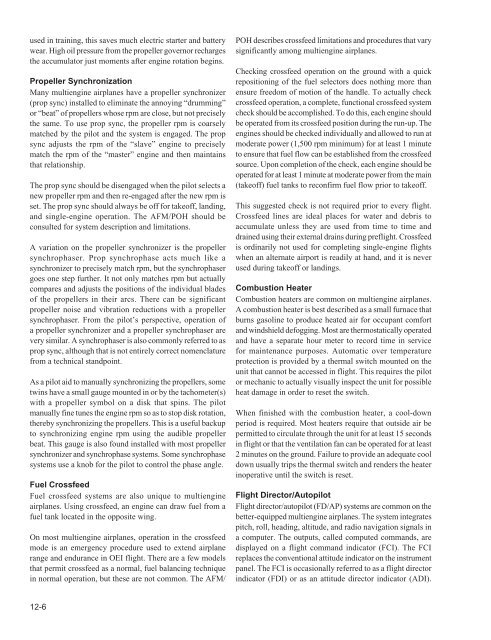Create successful ePaper yourself
Turn your PDF publications into a flip-book with our unique Google optimized e-Paper software.
used in training, this saves much electric starter and battery<br />
wear. High oil pressure from the propeller governor recharges<br />
the accumulator just moments after engine rotation begins.<br />
Propeller Synchronization<br />
Many multiengine airplanes have a propeller synchronizer<br />
(prop sync) installed to eliminate the annoying “drumming”<br />
or “beat” of propellers whose rpm are close, but not precisely<br />
the same. To use prop sync, the propeller rpm is coarsely<br />
matched by the pilot and the system is engaged. The prop<br />
sync adjusts the rpm of the “slave” engine to precisely<br />
match the rpm of the “master” engine and then maintains<br />
that relationship.<br />
The prop sync should be disengaged when the pilot selects a<br />
new propeller rpm and then re-engaged after the new rpm is<br />
set. The prop sync should always be off for takeoff, landing,<br />
and single-engine operation. The AFM/POH should be<br />
consulted for system description and limitations.<br />
A variation on the propeller synchronizer is the propeller<br />
synchrophaser. Prop synchrophase acts much like a<br />
synchronizer to precisely match rpm, but the synchrophaser<br />
goes one step further. It not only matches rpm but actually<br />
compares and adjusts the positions of the individual blades<br />
of the propellers in their arcs. There can be significant<br />
propeller noise and vibration reductions with a propeller<br />
synchrophaser. From the pilot’s perspective, operation of<br />
a propeller synchronizer and a propeller synchrophaser are<br />
very similar. A synchrophaser is also commonly referred to as<br />
prop sync, although that is not entirely correct nomenclature<br />
from a technical standpoint.<br />
As a pilot aid to manually synchronizing the propellers, some<br />
twins have a small gauge mounted in or by the tachometer(s)<br />
with a propeller symbol on a disk that spins. The pilot<br />
manually fine tunes the engine rpm so as to stop disk rotation,<br />
thereby synchronizing the propellers. This is a useful backup<br />
to synchronizing engine rpm using the audible propeller<br />
beat. This gauge is also found installed with most propeller<br />
synchronizer and synchrophase systems. Some synchrophase<br />
systems use a knob for the pilot to control the phase angle.<br />
Fuel Crossfeed<br />
Fuel crossfeed systems are also unique to multiengine<br />
airplanes. Using crossfeed, an engine can draw fuel from a<br />
fuel tank located in the opposite wing.<br />
On most multiengine airplanes, operation in the crossfeed<br />
mode is an emergency procedure used to extend airplane<br />
range and endurance in OEI flight. There are a few models<br />
that permit crossfeed as a normal, fuel balancing technique<br />
in normal operation, but these are not common. The AFM/<br />
POH describes crossfeed limitations and procedures that vary<br />
significantly among multiengine airplanes.<br />
Checking crossfeed operation on the ground with a quick<br />
repositioning of the fuel selectors does nothing more than<br />
ensure freedom of motion of the handle. To actually check<br />
crossfeed operation, a complete, functional crossfeed system<br />
check should be accomplished. To do this, each engine should<br />
be operated from its crossfeed position during the run-up. The<br />
engines should be checked individually and allowed to run at<br />
moderate power (1,500 rpm minimum) for at least 1 minute<br />
to ensure that fuel flow can be established from the crossfeed<br />
source. Upon completion of the check, each engine should be<br />
operated for at least 1 minute at moderate power from the main<br />
(takeoff) fuel tanks to reconfirm fuel flow prior to takeoff.<br />
This suggested check is not required prior to every flight.<br />
Crossfeed lines are ideal places for water and debris to<br />
accumulate unless they are used from time to time and<br />
drained using their external drains during preflight. Crossfeed<br />
is ordinarily not used for completing single-engine flights<br />
when an alternate airport is readily at hand, and it is never<br />
used during takeoff or landings.<br />
Combustion Heater<br />
Combustion heaters are common on multiengine airplanes.<br />
A combustion heater is best described as a small furnace that<br />
burns gasoline to produce heated air for occupant comfort<br />
and windshield defogging. Most are thermostatically operated<br />
and have a separate hour meter to record time in service<br />
for maintenance purposes. Automatic over temperature<br />
protection is provided by a thermal switch mounted on the<br />
unit that cannot be accessed in flight. This requires the pilot<br />
or mechanic to actually visually inspect the unit for possible<br />
heat damage in order to reset the switch.<br />
When finished with the combustion heater, a cool-down<br />
period is required. Most heaters require that outside air be<br />
permitted to circulate through the unit for at least 15 seconds<br />
in flight or that the ventilation fan can be operated for at least<br />
2 minutes on the ground. Failure to provide an adequate cool<br />
down usually trips the thermal switch and renders the heater<br />
inoperative until the switch is reset.<br />
Flight Director/Autopilot<br />
Flight director/autopilot (FD/AP) systems are common on the<br />
better-equipped multiengine airplanes. The system integrates<br />
pitch, roll, heading, altitude, and radio navigation signals in<br />
a computer. The outputs, called computed commands, are<br />
displayed on a flight command indicator (FCI). The FCI<br />
replaces the conventional attitude indicator on the instrument<br />
panel. The FCI is occasionally referred to as a flight director<br />
indicator (FDI) or as an attitude director indicator (ADI).<br />
12-6


